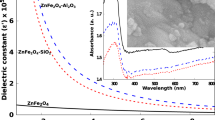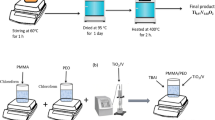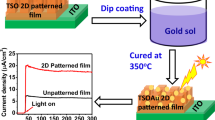Abstract
Thermally stable, optically active inorganic nanocomposites, i.e., aluminum–silicate (AS) and silica–titania (ST), are synthesized via acid-catalyzed low-temperature sol–gel method in order to get stable, crack-free coating material for photonic devices. The samples are characterized by atomic force microscope, field emission scanning electron microscope (FE-SEM), energy-dispersive X-ray spectroscopy (EDX), X-ray diffraction (XRD), Fourier transform infrared spectroscopy (FTIR), Brunauer–Emmett––Teller (BET) surface area, Barrett–Joyner–Halenda (BJH) pore size distribution surface analysis and UV–Vis spectroscopy. Microscopic results show good incorporation of ST and AS particles as composites with grain size within range of 12–17 and 62–109 nm, respectively. EDX analysis substantiated the stoichiometric formation of homogeneous nanocomposites. XRD of the films reveals primary polycrystalline anatase titania phase and mullite phase of ST and AS nanocomposites. FTIR confirms the heterogeneous bond linkage between titania, silica and alumina species. Furthermore, the fabricated samples have mesoporous nature with high surface area, large pore volume and diameter. The tunable refractive index of 1.33–1.35 with high transparency is obtained for synthesized nanocomposites. The experimental findings show that these physically modified and thermally stable alumina- and titania-doped silica-based composite coatings are promising for photonic devices modification.







Similar content being viewed by others
References
G. Wicht, R. Ferrini, S. Schuttel, L. Zuppiroli, Nanoporous films with low refractive index for large-surface broad-band anti-reflection coatings. Macromol. Mater. Eng. 295, 628–636 (2010)
A thesis submitted by Refik Sina Toru, Novel Nanocomposite Coatings of Nanoparticles, Degree of Master of Science, April 2011 Bilkent University, 1–74
S. Islam, R. Rahman, Z. Othaman, S. Riaz, M.A. Saeed, S. Naseem, Preparation and characterization of crack-free sol–gel based SiO2–TiO2 hybrid nanoparticle film. J. Sol-Gel. Sci. Technol. 68, 162–168 (2013)
S. Riaz, S. Naseem, Controlled nanostructuring of TiO2 nanoparticles—a sol gel approach. J. Sol-Gel. Sci. Technol. 74(2), 299–309 (2015)
S. Islam, N. Bidin, S. Riaz, S. Naseem, Sol–gel based phenolphthalein encapsulated heterogeneous silica–titania optochemical pH nanosensor. J. Ind. Eng. Chem. 34, 258–268 (2016)
S. Islam, N. Bidin, S. Riaz, S. Naseem, F.M. Marsin, Mesoporous SiO2–TiO2 nanocomposite for pH sensing. Sens. Actuators B: Chem. 221, 993–1002 (2015)
M.M.S. Sanad, M.M. Rashad, E.A. Abdel-Aal, M.F. El-Shahat, K. Powers, Effect of Y3+, Gd3+ and La3+ dopant ions on structural, optical and electrical properties of o-mullite nanoparticles. J. Rare Earths 32(1), 37 (2014)
S. Islam, N. Bidin, S. Riaz, S. Naseem, F.M. Marsin, Correlation between structural and optical properties of surfactant assisted sol–gel based mesoporous SiO2–TiO2 hybrid nanoparticles for pH sensing/optochemical sensor. Sens. Actuators B: Chem. 225, 66–73 (2016)
Y.H. Tana, J.A. Davis, K. Fujikawa, N.V. Ganesh, A.V. Demchenko, K.J. Stinea, Surface area and pore size characteristics of nanoporous gold subjected to thermal, mechanical, or surface modification studied using gas adsorption isotherms, cyclic voltammetry, thermogravimetric analysis, and scanning electron microscopy. J. Mater. Chem. 22(14), 6733–6745 (2012)
J.A.S. Costa, A.C.F.S. Garcia, D.O. Santos, V.H.V. Sarmento, A.L.M. Porto, M.E. Mesquita, L.P.C. Romao, A new functionalized MCM-41 mesoporous material for use in environmental applications. J. Braz. Chem. Soc. 25(2), 197–207 (2014)
H. Mehranpour, M. Askari, M. Sasani Ghamsari, H. Farzalibeik, Study on the phase transformation kinetics of Sol-Gel drived TiO2 nanoparticles. J. Nanomater. 2010, 626978 (2010)
J. Sanz, A. Madani, J.M. Serratosa, J.S. Moya, S. Aza, Aluminum-27 and silicon-29 magic-angle spinning nuclear magnetic resonance study of the kaolinite-mullite transformation. J. Am. Ceramic Soc. 71(10), C418–C421 (1988)
J.A. Navio, G. Colon, P.J. Sanchez-Soto, M. Macias, Effects of H2O2 and SO42-species on the crystalline structure and surface properties of ZrO2 processed by alkaline precipitation. Chem. Mater. 9(5), 1256–1261 (1997)
J. Pascual, J. Zapatero, C. Maroaa, J.A. Haro, I. Varona, A. Justo, J. Pearez-Rodroaguez, P.J. Saanchez-Soto, Porous mullite and mullite-based composites by chemical processing of kaolinite and aluminium metal wastes. J. Mater. Chem. 10, 1409–1414 (2000)
Thesis by Giovanni Schiavon, Sol-Gel Derived Nanocomposites-Synthesis, Spectroscopy, Atomic Force Microscopy, Technische University Mnchen
L.A. Aksay, D.M. Dabbs, M. Sarikaya, Mullite for structural, electronic, and optical applications. J. Am. Ceramic Soc. 74, 2343–2358 (1991)
X. Wang, G. Wu, B. Zhou, Materials. 6, 2819–2830 (2013)
S. Islam, R.A. Rahman, Z. Othaman, S. Riaz, S. Naseem, Synthesis and characterization of hybrid matrix with encapsulated organic sensing dyes for pH sensing application. J. Ind. Eng. Chem. 20, 4408–4414 (2014)
Acknowledgments
The authors like to express their gratitude to the Government of Malaysia through grant FRGS vote 4F543 for the financial support in this project. Thanks are also due to UTM through RMC for awarding the Postdoctoral fellowship to the first author.
Author information
Authors and Affiliations
Corresponding author
Rights and permissions
About this article
Cite this article
Islam, S., Bidin, N., Riaz, S. et al. Mesoporous nanocomposite coatings for photonic devices: sol–gel approach. Appl. Phys. A 122, 935 (2016). https://doi.org/10.1007/s00339-016-0430-z
Received:
Accepted:
Published:
DOI: https://doi.org/10.1007/s00339-016-0430-z




